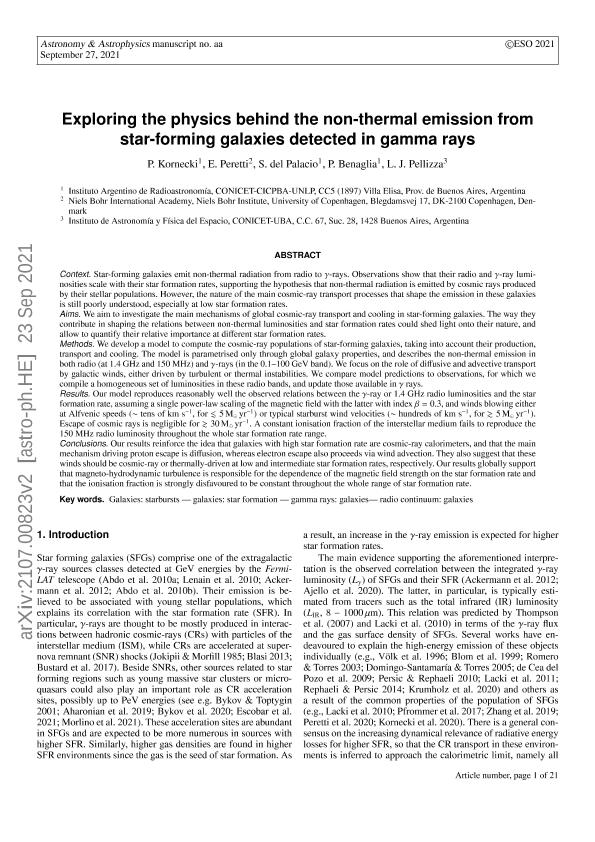Mostrar el registro sencillo del ítem
dc.contributor.author
Kornecki, Paula

dc.contributor.author
Peretti, E.
dc.contributor.author
del Palacio, Santiago

dc.contributor.author
Benaglia, Paula

dc.contributor.author
Pellizza González, Leonardo Javier

dc.date.available
2023-10-18T13:53:12Z
dc.date.issued
2022-01
dc.identifier.citation
Kornecki, Paula; Peretti, E.; del Palacio, Santiago; Benaglia, Paula; Pellizza González, Leonardo Javier; Exploring the physics behind the non-thermal emission from star-forming galaxies detected in γ rays; EDP Sciences; Astronomy and Astrophysics; 657; 1-2022; 1-21
dc.identifier.issn
0004-6361
dc.identifier.uri
http://hdl.handle.net/11336/215306
dc.description.abstract
Context. Star-forming galaxies emit non-thermal radiation from radio to γ rays. Observations show that their radio and γ-ray luminosities scale with their star formation rates, supporting the hypothesis that non-thermal radiation is emitted by cosmic rays produced by their stellar populations. However, the nature of the main cosmic-ray transport processes that shape the emission in these galaxies is still poorly understood, especially at low star formation rates. Aims. Our aim is to investigate the main mechanisms of global cosmic-ray transport and cooling in star-forming galaxies. The way they contribute to shaping the relations between non-thermal luminosities and star formation rates could shed light onto their nature, and allow us to quantify their relative importance at different star formation rates. Methods. We developed a model to compute the cosmic-ray populations of star-forming galaxies, taking into account their production, transport, and cooling. The model is parametrised only through global galaxy properties, and describes the non-thermal emission in radio (at 1.4 GHz and 150 MHz) and γ rays (in the 0.1-100 GeV band). We focused on the role of diffusive and advective transport by galactic winds, either driven by turbulent or thermal instabilities. We compared model predictions to observations, for which we compiled a homogeneous set of luminosities in these radio bands, and updated those available in γ rays. Results. Our model reproduces reasonably well the observed relations between the γ-ray or 1.4 GHz radio luminosities and the star formation rate, assuming a single power-law scaling of the magnetic field (with index β = 0.3) and winds blowing either at Alfvenic speeds (∼tens of km s-1, for 5 Mpdbl yr-1) or typical starburst wind velocities (∼hundreds of km s-1, for 5 Mpdbl yr-1). Escape of cosmic rays is negligible for 30 Mpdbl yr-1. A constant ionisation fraction of the interstellar medium fails to reproduce the 150 MHz radio luminosity throughout the whole star formation rate range. Conclusions. Our results reinforce the idea that galaxies with high star formation rates are cosmic-ray calorimeters, and that the main mechanism driving proton escape is diffusion, whereas electron escape also proceeds via wind advection. They also suggest that these winds should be cosmic-ray or thermally driven at low and intermediate star formation rates, respectively. Our results globally support that magneto-hydrodynamic turbulence is responsible for the dependence of the magnetic field strength on the star formation rate and that the ionisation fraction is strongly disfavoured to be constant throughout the whole range of star formation rates.
dc.format
application/pdf
dc.language.iso
eng
dc.publisher
EDP Sciences

dc.rights
info:eu-repo/semantics/openAccess
dc.rights.uri
https://creativecommons.org/licenses/by-nc-sa/2.5/ar/
dc.subject
GALAXIES: STAR FORMATION
dc.subject
GALAXIES: STARBURST
dc.subject
GAMMA RAYS: GALAXIES
dc.subject
RADIO CONTINUUM: GALAXIES
dc.subject.classification
Astronomía

dc.subject.classification
Ciencias Físicas

dc.subject.classification
CIENCIAS NATURALES Y EXACTAS

dc.title
Exploring the physics behind the non-thermal emission from star-forming galaxies detected in γ rays
dc.type
info:eu-repo/semantics/article
dc.type
info:ar-repo/semantics/artículo
dc.type
info:eu-repo/semantics/publishedVersion
dc.date.updated
2023-10-12T11:28:08Z
dc.journal.volume
657
dc.journal.pagination
1-21
dc.journal.pais
Francia

dc.description.fil
Fil: Kornecki, Paula. Provincia de Buenos Aires. Gobernación. Comisión de Investigaciones Científicas. Instituto Argentino de Radioastronomía. Consejo Nacional de Investigaciones Científicas y Técnicas. Centro Científico Tecnológico Conicet - La Plata. Instituto Argentino de Radioastronomía; Argentina
dc.description.fil
Fil: Peretti, E.. Universidad de Copenhagen; Dinamarca
dc.description.fil
Fil: del Palacio, Santiago. Provincia de Buenos Aires. Gobernación. Comisión de Investigaciones Científicas. Instituto Argentino de Radioastronomía. Consejo Nacional de Investigaciones Científicas y Técnicas. Centro Científico Tecnológico Conicet - La Plata. Instituto Argentino de Radioastronomía; Argentina
dc.description.fil
Fil: Benaglia, Paula. Provincia de Buenos Aires. Gobernación. Comisión de Investigaciones Científicas. Instituto Argentino de Radioastronomía. Consejo Nacional de Investigaciones Científicas y Técnicas. Centro Científico Tecnológico Conicet - La Plata. Instituto Argentino de Radioastronomía; Argentina
dc.description.fil
Fil: Pellizza González, Leonardo Javier. Consejo Nacional de Investigaciones Científicas y Técnicas. Oficina de Coordinación Administrativa Ciudad Universitaria. Instituto de Astronomía y Física del Espacio. - Universidad de Buenos Aires. Facultad de Ciencias Exactas y Naturales. Instituto de Astronomía y Física del Espacio; Argentina
dc.journal.title
Astronomy and Astrophysics

dc.relation.alternativeid
info:eu-repo/semantics/altIdentifier/doi/http://dx.doi.org/10.1051/0004-6361/202141295
Archivos asociados
